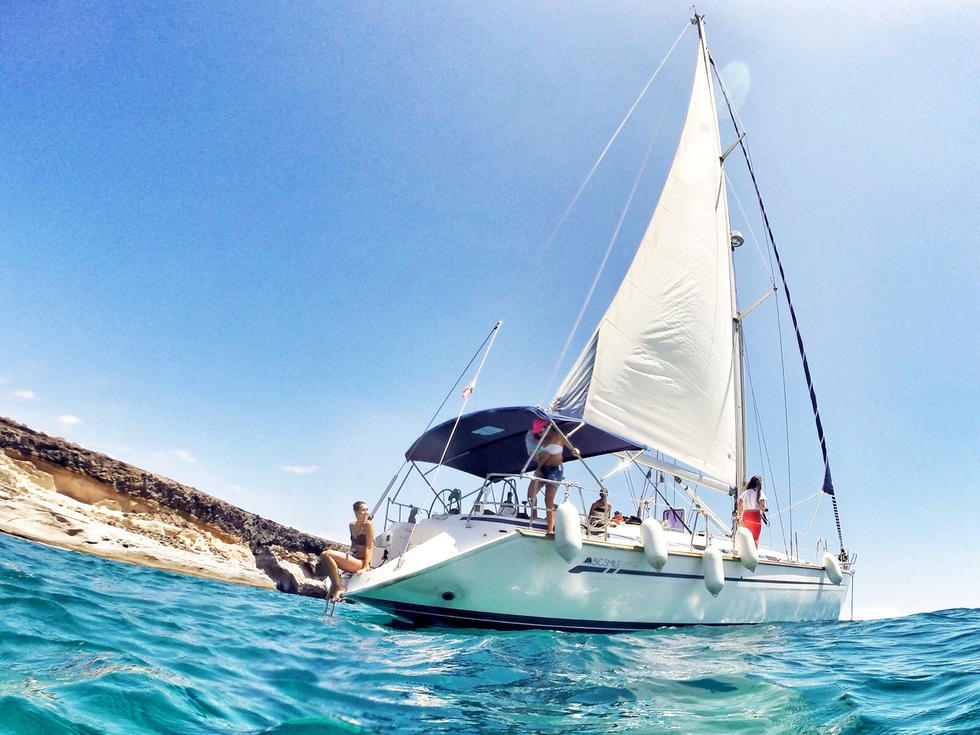If you love the Ocean – Whale & Dolphing watching
If you are going to visit Tenerife, to take a Whale and Dolphin watching boat trip is a kind of must-do activity. Here you can find all the Whale & Dolphin boat trips and private boat charters in Tenerife, so you can choose the between different kind of boats, sailing yachts, catamarans, ships, etc. To help you to understand what kind of whales and dolphins you can see in Tenerife, we publish this and next articles.
Generally, we can classify whales and dolphins in Tenerife and Canary Islands in 4 different groups:
- Resident Whales & Dolphins you will almost surely see along a boat trip in Tenerife – species that live in fixed areas whole the year long. And this article is about them 🙂
- Occasional Whales & Dolphins you can see sometimes long with a boat trip in Tenerife – species that visits island occasionally without a regular frequency.
- Migrating Whales & Dolphins you have a chance to see along a boat trip in Tenerife – species that appears by the island on a seasonal basis.
- Rarely-seen Whales & Dolphins you nearly have no chances to see in Tenerife unless you are really very lucky – species that were observed by the island very rarely.
This article is about the most common whales and dolphins you can see always, all the year along, taking a Whale & Dolphin Watching boat trip in Tenerife.
RESIDENT WHALES & DOLPHINS IN TENERIFE
No matter are you going on a Whale & Dolphin Watching boat trip in Tenerife in winter or summer, you can always see these 2 resident species living constantly in the waters of Tenerife – Short-finned Pilot Whale and Bottlenose Dolphin – they simply live here and Tenerife is their home. Which of them will you see or maybe you will have a chance to see both? Well, it mainly depends on how long your boat trip in Tenerife is and what kind of boat will you take. Let’s say so – with any Whale & Dolphin boat trip in Tenerife you will see the Short-finned Pilot Whale. Even with a shortest and cheapest 2-hour long whale watching boat trip or even trekking tour in Masca Canyon combined with Dolphin watching. It’s because short-finned pilot whales are taking rest on the surface of the ocean along the day and our captains know where they have to sail the boat to see them. The difference is only, if you will take a boat trip with a sailing yacht then you can come closer, but don’t worry if you are going to see whales and dolphins taking a cheaper boat trip in Tenerife by catamaran – you will still see them quite close.
A bit different story with Bottlenose Dolphin – here’s no matter are you taking boat trip by sailing yacht in Tenerife or a whale & dolphin watching boat trip by catamaran. What’s important, if you wish to see Bottlenose Dolphins is how long your boat trip is. It because not like Short-finned Pilot Whales, staying more or less in the same areas, Bottlenose Dolphins are much more active and they always moving, so as long you stay on the boat and as long your boat trip is, as more chances to see these amazing dolphins you have. We can say a kind of 5-6 hour boat trip from along the southern coast of Tenerife it’s nearly warrantied you will see them, but with 2 or 3 hours long boat trip there are much fewer chances.
So, now let’s learn more about these beautiful species.
Short-finned Pilot Whale

Short-finned pilot whales are very sociable and almost never seen alone. They live in groups of 10 to 30, but some pods are as large as 50. In a few sittings of pods, over several hundred animals have also been recorded. Pods are primarily matrilineal, or a female-based society. Some older females have been recorded actually taking care of calves that are not their own. Males are polygynous, meaning they will mate with multiple females at one time or throughout their lives. Pods are often found with around one mature male per every eight mature females. Maturing males will often leave their birth school, but most females will stay in the same pod their entire lives. They have sometimes seen logging and will allow boats to get quite close. They rarely breach but may be seen lob tailing (slapping their flukes on the water surface) and spy-hopping (poking their heads above the surface). Before diving, they arch their tails and raise them above the surface. When coming to the surface to breathe, adults tend to show only the tops of their heads, whereas calves will throw their entire heads out of the water. Adults occasionally porpoise (left most of the body out of the water) when swimming particularly quickly.
Females mature at about 10 years of age and will start having calves every five to eight years. A female may nurse a calf for up to 15 years as long as it is the last born calf. Their gestation period lasts just over a year, and a female will have from four to six calves in her lifetime. A calf will suckle from its mother for a minimum of two years, but most will for nearly five years. A female will usually stop reproducing once reaching the age of about 40 years.
The short-finned pilot whale primarily feeds on squid, but will also feed on certain species of fish and octopus. They feed nearly 300 meters (1000 ft) deep or more and spend great lengths of time at depth. A pod may spread out up to 800 meters (0.5 mi) to cover more area to find food. They have also been reported to “harass” sperm whales and dolphins, so marine mammals could also potentially be part of their diets. They are known as the ‘cheetahs of the deep’ for the high-speed pursuits of squid at depths of hundreds of meters.
Adults males are about 5.5 meters (18 ft) in length, whereas adult females only reach about 3.7 meters (12 ft) in length. Adults can weigh from 1,000 to 3,000 kg (2200-6600 lbs). When they are born, short-finned pilot whales are about 1.4–1.9 m (4 ft 7 in–6 ft 3 in) long and weigh about 60 kg (130 lb). Males live nearly 45 years, whereas females can live up to 60 years.
Bottlenose Dolphin

Bottlenose dolphins are well known as the intelligent and charismatic stars of many aquarium shows. Their curved mouths give the appearance of a friendly, permanent smile, and they can be trained to perform complex tricks.
In the wild, these sleek swimmers can reach speeds of over 18 miles an hour the surface often to breathe, doing so two or three times a minute. Bottlenose dolphins travel in social groups and communicate with each other by a complex system of squeaks and whistles. Schools have been known to come to the aid of an injured dolphin and help it to the surface.
Bottlenose dolphins track their prey through the expert use of echolocation. They can make up to 1,000 clicking noises per second. These sounds travel underwater until they encounter objects, then bounce back to their dolphin senders, revealing the location, size, and shape of their target.
Adult males live mostly alone or in groups of two to three, and join pods for short periods of time. Adult females and young dolphins normally live in groups of up to 15 animals. However, they live in fission-fusion societies of varying group size, within which individuals change associations, often on a daily or hourly basis.Group compositions are usually determined by sex, age, reproductive condition, familial relations and affiliation histories. Smaller groups can join to form larger groups of 100 or more and occasionally exceed even 1,000. The social strategies of marine mammals such as bottlenose dolphins provide interesting parallels with the social strategies of elephants and chimpanzees.
When dolphins are feeding, that target is often a bottom-dwelling fish, though they also eat shrimp and squid. These clever animals are also sometimes spotted following fishing boats in hopes of dining on leftovers. The presence of a floating marine fin-fish farm has been linked to a change in bottlenose dolphin distribution as a result of high fish density around the floating cages in the farming area.
The bottlenose dolphin has a single blowhole located on the dorsal surface of the head consisting of a hole and a muscular flap. The flap is closed during muscle relaxation and opens during contraction. Dolphins are voluntary breathers, who must deliberately surface and open their blowholes to get air. They can store almost twice as much oxygen in proportion to their body weight as a human can: the dolphin can store 36 milliliters (ml) of oxygen per kg of body weight, compared with 20 ml per kg for humans. This is an adaptation to diving.The bottlenose dolphin typically rises to the surface to breathe through its blowhole two to three times per minute, although it can remain submerged for up to 20 minutes.
Dolphins can breathe while “half-asleep”. During the sleeping cycle, one brain hemisphere remains active, while the other hemisphere shuts down. The active hemisphere handles surfacing and breathing behavior. The daily sleeping cycle lasts for about 8 hours, in increments of minutes to hours. During the sleeping cycle, they remain near the surface, swimming slowly or “logging”, and occasionally closing one eye.
Bottlenose dolphins are gray, varying from dark gray at the top near the dorsal fin to very light gray and almost white at the underside. This counter shading makes them hard to see, both from above and below, when swimming. Adults range from 2 to 4 meters (6.6 to 13.1 ft), and 150 to 650 kilograms (330 to 1,430 lb). Males are, on average, slightly longer and considerably heavier than females. In most parts of the world, the adults are about 2.5 m (8.2 ft), and 200 to 300 kilograms (440 to 660 lb). Their size varies considerably with habitat. Except in the eastern Pacific, dolphins in warmer, shallower waters tend to be smaller than those in cooler, pelagic waters.
Bottlenose dolphins can live for more than 40 years. Females typically live 5-10 years longer than males, with some females exceeding 60 years. This extreme age is rare and less than 2% of all Bottlenose dolphins will live longer than 60 years.
Bottlenose Dolphin can jump at a height of 6 meters (20 feet) up in the air – they use this to communicate with one another.



